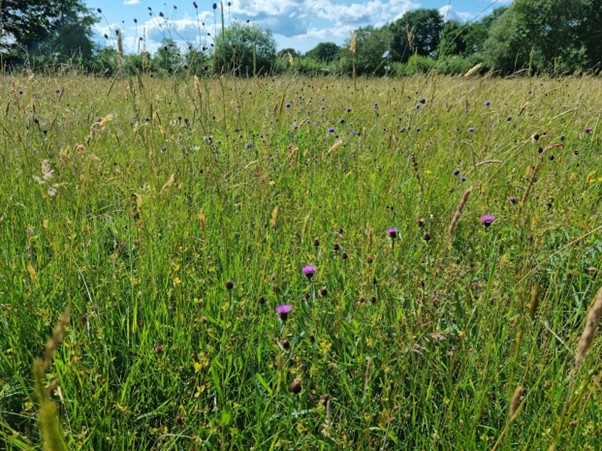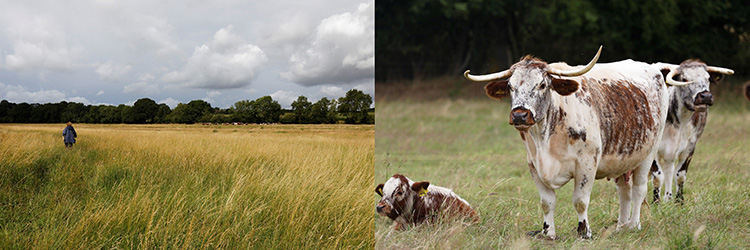Our summer survey season is usually pretty jam-packed, and this year was no exception. We mix a range of different objectives into about two months and try hard to make sure we are ticking multiple boxes wherever we go. We wanted to share with you what we got up to and what we thought about it, so here you go: a very rapid resume of the what, why and where of summer 2023…
 Left: Is this the largest dandelion leaf ever? A possible restoration field in Herefordshire. Right: Shropshire site surveys in progress.
Left: Is this the largest dandelion leaf ever? A possible restoration field in Herefordshire. Right: Shropshire site surveys in progress.
Visits to Floodplain Meadow Restoration Meadows
Our field surveys focused on meadow restoration projects as part of the third and final year of our Floodplain Meadows Restoration Project funded by the John Ellerman Foundation. Restoration meadows that we are aware of have been growing in number over the last few years. At each site, we try and talk to the landowner about what was done in terms of restoration and to: collect five 1 x 1 m botanical quadrat data; record a soil profile; and, occasionally, collect a soil sample to analyse for phosphorus. Phase 1 of this project finished in 2018 and resulted in a paper summarising our findings at that point. Phase 2 started in 2021 and finishes in early 2024.
During this second phase we were able to re-visit some sites we had visited in Phase 1. The most inspiring results so far have come out of re-surveys of restoration sites we visited in 2016-2017 – giving them a good amount of time to change. We have seen very good progress towards taxonomically and functionally diverse plant communities recorded in three sites next to ancient species-rich hay meadows including Mottey Meadows National Nature Reserve (Staffordshire), Clattinger Farm (Wiltshire), and Yarnton and Cassington Meads (Oxfordshire). Several other sites made noticeable progress in species richness or in goodness-to-fit to NVC plant communities. However, the functional diversity of restoration meadows is proving to develop very slowly. We are planning to produce a second paper based on our findings from this phase of the project next year.
Our survey season this year also included visiting several sites for potential meadow restoration, particularly in the River Wye catchment, but also in Buckinghamshire where all the sites we saw were almost totally dominated by grasses. The lack of forbs might be explained by either an excess of soil nutrients or the possible effect from herbicides entering the river from upstream arable fields, and subsequently polluting the meadows through floodwater. No herbicides were known to have been applied directly in the fields, nor was there evidence of re-seeding. Some of the fields had low soil fertility recorded and typically there was a reasonable range of grasses.
 Mottey Meadows NNR restoration field – green hay strewn in 2011. Making great progress in species and functional diversity.
Mottey Meadows NNR restoration field – green hay strewn in 2011. Making great progress in species and functional diversity.
Research sites
Long-term monitoring of vegetation and hydrological regimes continued in North Meadow Nature Reserve, Elmlea SSSI (Wiltshire) and Ducklington Mead (Oxfordshire). Re-surveys of these ancient hay meadows has become critically important because of various development activities and changes in hydrological regimes in the River Thames adjacent to the meadows.
Project-based work
We also enjoyed an epic season working in the Windrush catchment, with Partners North-East Cotswolds Farmer Cluster and FWAG-SW, through a Farming in Protected Landscapes (FiPL) funded project. This work was to gather data about the catchment, with the objective of producing a 20-year floodplain meadow restoration strategy and seeking funds for landscape-scale restoration. This small catchment seems to enjoy a number of outstanding floodplain meadows, and our survey has identified quite a few more, as well as helping to produce detailed restoration plans for 5 sites. There is plenty of potential for restoration here, with possible sites also identified.
We finished off the field season with a soils-based visit to Herefordshire in October to look at Lugg Meadows and Bartonsham Meadows with a range of partners, to understand soils and hydrology, understand current conditions and look at potential and restoration. Very exciting!
We hope to be able to continue with our visits to restoration fields and our long-term surveys next year, and also to continue to visit potential restoration fields, to help share what we have learnt and provide support and advice. We will also be visiting sites in South Wales as part of the development of a Welsh Floodplain Meadows Restoration project.
The methods that we are using to cover whole catchments with our surveys, gleaning enough information to tell us about soils and water regimes as well as plant communities, might also be of interest if you are planning something similar. Do get in touch.
 Potential restoration fields in Buckinghamshire where herbicides were applied until 5 years ago. The farmer here is very interested in increasing the diversity and restoring meadows.
Potential restoration fields in Buckinghamshire where herbicides were applied until 5 years ago. The farmer here is very interested in increasing the diversity and restoring meadows.